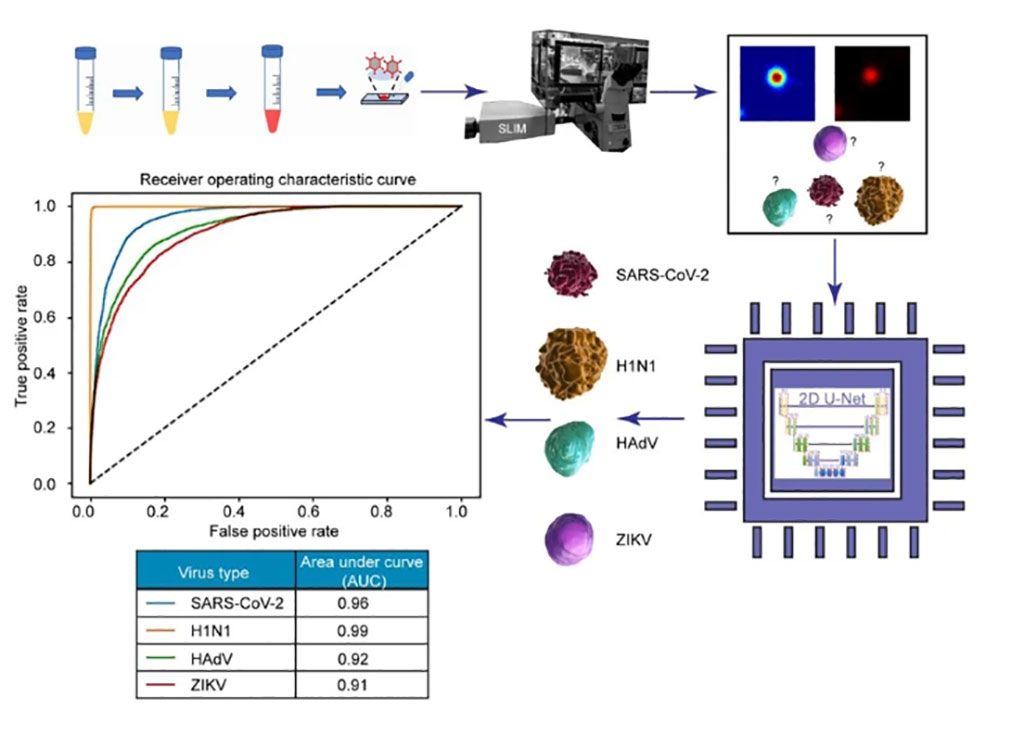COVID-19 Test Combines Label-Free Microscopic Imaging and AI to Deliver Fast and Accurate Results
By LabMedica International staff writers
Posted on 13 Sep 2021
A new COVID-19 test combines label-free microscopic imaging with artificial intelligence (AI) to quickly detect and classify the SARS-CoV-2 virus.Posted on 13 Sep 2021
Researchers from the Beckman Institute for Advanced Science and Technology at the University of Illinois at Urbana-Champaign (Champaign, IL, USA) have paired microscopy with AI to develop the new COVID-19 test that is fast, accurate, and cost-effective.

Image: The AI discerned between four particles: SARS-CoV-2, H1N1, HAdV, and ZIKV. The preclinical trial resulted in a 96% success rate for SARS-CoV-2 detection and classification (Photo courtesy of Beckman Institute for Advanced Science and Technology)
The team observed that while many techniques currently exist to test for SARS-CoV-2, none use a label-free optical approach. The miniscule size of a single particle makes relying on sight alone a near impossibility, even with a microscope. Electron microscopy is useful for imaging a particle’s structure, but extensive preparation is required to ensure a sample’s visibility. Though necessary, this process can obscure the desired image. The researchers turned to a technique developed at Beckman typically reserved for visualizing cells: spatial light image microscopy, which facilitates chemical-free (or label-free) imaging.
“Applying SLIM for virus imaging is like looking at something without your glasses on. The image is blurry due to the viruses being smaller than the diffraction limit,” said Neha Goswami, a graduate student in bioengineering and a 2021 recipient of Beckman Institute’s Nadine Barrie Smith Memorial Fellowship. “However, owing to the high sensitivity of SLIM, we can not only detect the viruses, but also differentiate between different types.”
The researchers identified a creative way to identify the viruses based on SLIM data: AI. With the right training, an advanced deep neural network can be programmed to recognize even the blurriest of images. They introduced the AI program to a pair of images: a stained SARS-CoV-2 particle producing fluorescence, and a phase image captured with a fluorescence-SLIM multimodal microscope. The AI is trained to recognize these images as one and the same. Easily recognizable, the fluorescence-stained image functions like training wheels; with enough repetition, the machine learns to detect the viruses directly from the SLIM, label-free images without the added support.
After detection comes differentiation: discerning SARS-CoV-2 from other types of viruses and particles. The AI learned to discern between SARS-CoV-2 and other viral pathogens such as H1N1, or influenza A; HAdV, or adenovirus; and ZIKV, or Zika virus. The preclinical trial was highly successful, resulting in a 96% success rate for SARS-CoV-2 detection and classification. The project’s goal is a sensitive and specific viral breath test detection system that aids in viral diagnostics and in transmission prevention strategies; today, this could take the form of a rapid, high-throughput, low-cost COVID-19 test with the potential for portability and point-of-care action.
With clinical validation pending, researchers speculate that a COVID-19 test conducted with this method would look something like this: the subject would wear a face shield, onto which a clear glass slide would be attached; they would then complete an activity wherein their breath becomes fixed to the slide (like reading a paragraph out loud). The slide, and any particles attached to it, would be imaged and analyzed to detect any viruses present.
“There are two key advantages to this kind of COVID test,” Goswami said. “The first is speed: the duration can be of the order of one minute. The second is that we are not adding any chemicals or modifications to the samples provided. All we’d be paying for is the cost of the face shield and the slide itself.”
Related Links:
University of Illinois at Urbana-Champaign













